Changing oil is a pain. It’s messy; the little drain pans always leak, and no matter how hard you try, somehow oil ends up covering you head to toe. That might be an exaggeration, or at least we hope it is, but it is true that oil changes are often messy. An oil extractor changes all that. Instead of crawling under the car, you pull the oil out of the top into a super convenient self-contained unit. It’s really awesome.
Keep reading for our top oil extractor picks for 2026.
- Choosing the Best Oil Extractor
- The Key Considerations When Buying an Extractor
- Top 10 Best Oil Extractors 2026
- 1. Best Overall Pick: Mityvac Fluid Evacuator Plus
- 2. Best Premium Pick: Jabsco 17850-1012 Engine Oil Change System
- 3. Best Budget Pick: The Hydro-Turf Extractor
- 4. Best Multi-Purpose: Air Power America Topsider MVP
- 5. Best Portable: OEM TOOLS Fluid Extractor
- 6. Best Siphon: Koehler Enterprises RA990 Multi-Use Siphon
- 7. Best Lightweight Manual Extractor: Air Power America LiquiVac
- 8. Best for Low Volumes of Oil: Briggs & Stratton 5430K
- 9. Best Inexpensive Electric Pump: Mannew 12v 60w
- 10. Best Syringe-Style: Mityvac 7-½" Extractor
- All About Auto Oil Extraction
- Enjoy Easier, Cleaner Maintenance
Choosing the Best Oil Extractor
Fluid extractors come in a lot of shapes and sizes. Don’t worry, though, choosing the right one for you is actually really straightforward. We’ll prime you with some quick notes to allow you to get set up with the perfect extractor. Then we’ll review our top picks for you to choose from and make it even easier to find one that fits your needs.
Finally, we will cap it off with a bunch of relevant info on using your new extractor to keep your car healthy. First things first, why would you even use an extractor over the traditional drain and pray method?
The Key Considerations When Buying an Extractor
Now that you are convinced you need one, there are some things you have to consider in order to choose the best one for your situation.
Airpower, Hand Power, or Electric
Most extractors are powered by good old fashioned elbow grease. They have a hand pump that pulls air out of a container to create a vacuum. Some extractors, like the LiquiVac model we recommend, take a lot of pumps to charge up. Others like the Mityvac, take very little work because its hand pump is gigantic.
If you don’t feel like adding a workout into your oil change, consider options that utilize airpower or electricity. Electric pumps, like the one found on the Jabsco on our list, have clamps that hook to a car battery. Extractors that are air-powered need an air compressor and a hose. They use a venturi to draw a vacuum in the vessel, just like a hand pump. Most air-powered units, like the OEM TOOLS fluid extractor in the reviews, are also hand-powered to keep them convenient.
The Reservoir Size
Extractors come in thimble-sized, like the Briggs & Stratton here, to gigantic, like the Mityvac. You don’t want to have to stop and empty the container in the middle of a change, so pick one that can fit the amount of oil your engine holds. Some don’t have reservoirs at all, which means you’ll have to supply your own.
Ease of Use
There are a lot of little features that make using an extractor easier. Safety valves can keep the unit from overflowing and making a mess. Removable pumps can make storing a unit easier, and container shape can dictate how easy it is to pour the oil out after you’re done.
Cost
While cost can’t be your only consideration, we know it’s always a consideration. Generally, you’ll have to pay more for convenience. Faster, larger units cost more, whereas smaller or harder to use units cost less. If cost is a big consideration for you, just be prepared to put in the extra work.
Our goal with this top 10 list is to give you a variety of styles to choose from so you can quickly narrow down the perfect unit for your shop.
The options range from the ridiculously cheap but hard to use Koehler to the giant, fancy Mityvac. If you don’t want to think about it too hard though, don’t even bother with the list. Grab the Topsider, it’ll outlast your car, holds enough to drain a big motor, and doesn’t require anything but your biceps to use.
| Product | Powered by | Capacity | Speed | Rating |
|---|---|---|---|---|
| Mityvac Fluid Evacuator Plus | Hand pump or air compressor | 8.8qts | 10-15 minutes for an average engine | 5 |
| Jabsco 17850-1012 Engine Oil Change System | 12v motor | 14qts | 5 minutes for an average engine | 5 |
| The Hydro-Turf Extractor | Hand pump | 6.3qts | 8-13 minutes for an average engine | 4.5 |
| Air Power America Topsider MVP | Hand pump | 8qt | 15-20 minutes for an average engine | 4.5 |
| OEM TOOLS Fluid Extractor | Hand pump or air compressor | 6.3qt | 10-15 minutes for an average engine | 4.5 |
| Koehler Enterprises RA990 Multi-Use Siphon | Hand pump | Doesn’t come with its own reservoir | Really, really slow | 4 |
| Air Power America LiquiVac | Hand pump | 8qts | 15-20 minutes for an average engine | 4 |
| Briggs & Stratton 5430K | Hand pump | 1.7qts | 5 minutes for a lawnmower engine | 4 |
| Mannew 12v 60w | 12v electricity | Doesn’t come with its own reservoir | A few minutes for an average motor | 4 |
| Mityvac 7-½" Extractor | Hand plunger | 35qts | Pretty fast for ¼ quart, but it would take you all day to drain the average engine | 3.5 |
Top 10 Best Oil Extractors 2026
1. Best Overall Pick: Mityvac Fluid Evacuator Plus
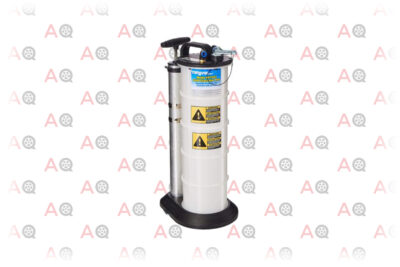
Editor’s Rating:
At a Glance:
- Powered by: Hand pump or air compressor
- Capacity: 8.8qts
- Speed: 10-15 minutes for an average engine
What Makes It Good?
This thing is the Cadillac of extractors. First, it holds 8.8qts, so you can drain the oil out of your big block Cadillac. Second, if you don’t feel like using the hand pump, you can just hook the thing to an air compressor instead.
If you do decide to use the hand pump, though, it’s one of the best on the list. You only need about ten good pumps to create enough vacuum to pull out the oil from an average engine. That really cuts down on the total time. The hand pump is also really well built, the whole unit is. Even though it has plastic parts, the plastic is thick, and the separate components come apart quickly for cleaning.
It also has special safety features like overflow protection. Only a few other units on this list have that. Notably, the OEM we mention here. That is super nice if you just want to hook it up to the dipstick tube and get lunch while draining.
What Could Be Better?
The first thing you’ll notice is the size. It’s a bit big and awkward. It’s definitely not an easy unit to lug around with you. That extra size also makes it more difficult to empty than something like the LiquiVac on this list. You could set the extractor to reverse and spray the contents out instead of pouring, but that can be messy and take a lot of time.
It costs a bit more than comparable units too. Those Caddy features come at Caddy prices. If you do a lot of fluids work, it’s totally worth it, but if you just want to change your oil every so often, a cheaper option like the Topsider will suit you just fine.
Pros
- Large reservoir
- Hand or air powered
- The hand pump builds pressure quickly, no sore arms
- Pulls out fluid very quickly
Cons
- Takes up a lot of space
- More expensive than other extractors

Editor’s Rating:
At a Glance:
- Powered by: 12v motor
- Capacity: 14qts
- Speed: 5 minutes for an average engine
What Makes It Good?
Electric pumps have two huge advantages over the hand and air pumps: they are way faster and require way less work, the Jabsco exemplifies that. Yeah, it might just be a 12v pump bolted to a paint bucket, but it’s everything you need to suck out a ton of oil quickly. It holds 14qts, and if you are a little crazy, you can upgrade it to 20qts using a 5-gallon pail.
It’s simple to use too, which is also a little bit of a downside, but we’ll get to that later. It has a red clamp that goes on the positive battery terminal and a black clamp for the negative terminal. You clip it into the power and turn it on and off with a switch on the back.
Finally, it’s a high-quality pump that you can rely on. Many people have to drive out to farm equipment, off-road projects, or boats at a dock who can’t afford to bring something that they can’t count on. The other electric extractor we list is very inexpensive, but it isn’t nearly as dependable as Jabsco.
What Could Be Better?
There are three significant downsides to the Jabsco. The first is a failure of all the electric pumps. If you don’t have a 12v battery, then it won’t work, the end. You probably will have your car nearby no matter what, but between short leads and short hoses, there’s no convenient way to make it work unless you have 12v on site. You will burn more calories carrying around a spare car battery than you will be pumping up a manual extractor like the Hydro-Turf. The novelty of the electric motor wears off quickly when you stack it up.
The second is the price. The price of convenience is often steep. In the Jabsco’s case, it’s really, really steep. You could buy and break a lot of Mannews for the price.
Finally, the pump is non-reversible. That means you can pump oil out of your engine into the bucket, but you can’t pump it out of the bucket. This is a minor thing and it’s simple enough to take the lid off and pour the bucket out. If you are doing a lot of oil changing, though, you’ll start wishing you could just turn it on and have the pump empty it.
Pros
- Massive reservoir capacity
- Electric pump means no sore arms
- Very portable despite the size
Cons
- Expensive
- Pump is not reversible
3. Best Budget Pick: The Hydro-Turf Extractor
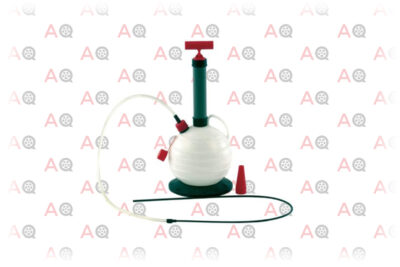
Editor’s Rating:
At a Glance:
- Powered by: Hand pump
- Capacity: 6.3qts
- Speed: 8-13 minutes for an average engine
What Makes It Good?
The Hydro-Turf is fast, simple, and lightweight. Unlike the heavier Topsider, it’s made of plastic through and through, and that’s not a terrible thing. It might not last as long, but it does make the unit lighter and more corrosion resistant.
The really nice thing that the Hydro-Turf brings to the table is a relatively large hand pump. The only thing that builds a vacuum faster by hand is the Mityvac, and the Hydro-Turf is half the size and weight. Like similarly designed “bulb” shaped units, the pump detaches, and the container is super easy to pour out.
What Could Be Better?
If you’ll allow us to be blunt, the Hydro-Turf costs more than the Topsider and holds less while only being a little bit faster.
We don’t want to knock it too hard though, it is a really good unit. Frankly, if you are just looking for something lightweight and easy to work with, it’s perfect. It’s better quality than the LiquiVac, which it directly competes with, and it’s not overly expensive.
Pros
- Lightweight and collapsible
- Large hand pump doesn't take much work to build pressure
- Long hose works well for a variety of motors
Cons
- Low capacity
- Plastic pump connection may weaken over time
4. Best Multi-Purpose: Air Power America Topsider MVP

Editor’s Rating:
At a Glance:
- Powered by: Hand pump
- Capacity: 8qt
- Speed: 15-20 minutes for an average engine
What Makes It Good?
The Topsider has a few features that really set it apart. It’s all-metal, first of all. It’s actually the only all-metal design on this list and that makes it really durable. Since it breaks down for storage too, it’s the perfect “throw it in the back of the truck” extractor that you can just keep with you and have it on hand.
It’s also got a big reservoir that’s easy to empty. That makes the Topsider able to handle just about any job, from a garden tractor to a Duramax truck. Only the Mityvac and the Jabsco have a larger capacity, but they have a price tag to match.
What Could Be Better?
The Topsider has a couple of downsides that might make you look at other options. First, and it’s a minor complaint but is unique to this unit, the metal construction makes it so you can’t tell how much fluid you’ve extracted. If that’s really an issue, the Hydro-Turf on the list is a very similar unit that’s plastic.
The Hydro-Turf also addresses the other, more substantial issue with the Topsider: it takes a lot of work to keep the Topsider pressurized. Units like the Mityvac only need a few pumps to extract all the oil from an average-sized engine. With the Topsider, you will be looking at 30-40. It’s an easy pump to operate, you don’t need to eat a big meal the day before or anything, but it does take longer than other units just because it requires more pumping.
Pros
- Compact and collapsible
- All metal construction
- Very easy to use
- Large reservoir
Cons
- Your arm might get tired
- Can't see how much fluid you've extracted
5. Best Portable: OEM TOOLS Fluid Extractor
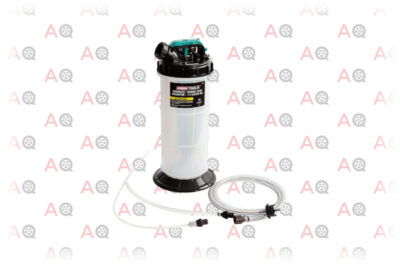
Editor’s Rating:
At a Glance:
- Powered by: Hand pump or air compressor
- Capacity: 6.3qt
- Speed: 10-15 minutes for an average engine
What Makes It Good?
Like the Mityvac, OEM TOOL’S extractor is both hand-powered or air-powered. The OEM is smaller, though. It only has a 6qt capacity. That’s fine for most cars, but you might have to empty it twice if you’re working on a larger motor.
Being smaller is its defining feature. Not only is the reservoir smaller, but the design is a lot more compact than the Mityvac’s. The hand pump is in the center of the unit instead of off to the side. It’s perfect if you need something really portable.
The OEM also has overflow protection, so you don’t have to worry about it spilling everywhere. It also has a spout on top that makes pouring out the contents super easy. It’s little things like that that make the OEM one of the easiest pumps to live with if you don’t have much of a shop.
What Could Be Better?
Not a whole lot, actually. It costs a lot, almost the same as the Mityvac, despite being smaller, so there’s that. You won’t get the combination of compactness and features in anything else, though.
Probably the biggest thing that OEM needs to improve on is their included hoses. The dipstick filler hose leaves some things to be desired, it’s not long enough to be really convenient. You can buy different sizes, but it’d be nice if they just included another foot on the one they give you.
Pros
- Hand or air operation
- Manual pump is large and only takes a few pumps to work well
- Very compact
Cons
- Won't hold all the oil from a large displacement engine
- Dipstick hose is too short for some vehicles and requires additional purchase
6. Best Siphon: Koehler Enterprises RA990 Multi-Use Siphon
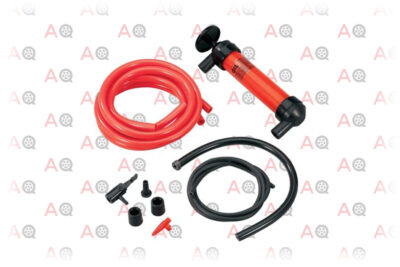
Editor’s Rating:
At a Glance:
- Powered by: Hand pump
- Capacity: Doesn’t come with its own reservoir
- Speed: Really, really slow
What Makes It Good?
We want to start off by saying that even though the list of good things about the Koehler is short, it’s worth a look. It’s really, really cheap. If nothing else, buy one as a backup for everything else on the list.
Every mechanic or DIYer should have a simple transfer pump in their toolkit anyway. They are good for tons of things, like draining a radiator, siphoning out oil from a hard to reach spot like a differential, and filling a bike tire. Sure, literally any product designed to do any of those tasks will do it better, but a small transfer pump can do it all. That makes it invaluable since dedicated machines sometimes break or cost too much.
What Could Be Better?
It’s slow, to start. The idea is to create a siphon and allow gravity to do all the work for you. However, with high viscosity fluids like oil, what ends up happening is you’ll continuously be pumping. Since it’s only as fast as you can pump, you’ll be pumping for a very long time to extract the oil from anything that has a decent capacity.
You also have to source your own bucket to drain into, and hope that the pressure fit hoses don’t pop off and spray oil in your face if you get a kink or accidentally suck up some debris. Like we pointed out before, it’s not a great solution to any problem. It can do the job simply, and it’s cheap.
Pros
- Very inexpensive
- Tiny and easy to carry around
- Versatile
Cons
- You have to find your own bucket
- If your vehicle has a lot of oil, you'll be pumping forever
7. Best Lightweight Manual Extractor: Air Power America LiquiVac
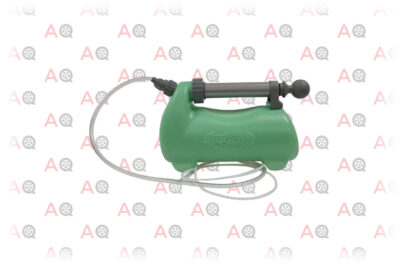
Editor’s Rating:
At a Glance:
- Powered by: Hand pump
- Capacity: 8qts
- Speed: 15-20 minutes for an average engine
What Makes It Good?
The LiquiVac is a neat little system. It’s a lot like the Topsider tool when you compare the numbers. It holds 8qts like the Topsider, but the LiquiVac takes a lot more priming like it as well. What really sets it apart is how lightweight and compact the engineers made the LiquiVac. They mounted the hand pump sideways so that it takes up less space, and the hand pump is the handle for carrying and pouring.
That makes this little unit perfect for working in tight spaces. If you have a cramped engine compartment that doesn’t offer much maneuvering room, take a look at this unit.
It’s also the cheapest full feature unit we suggest; once you get cheaper, you make some real sacrifices. The other inexpensive pumps we list either don’t have a reservoir or are so tiny you would never want to do a complete automotive oil change.
What Could Be Better?
It’s a pain to pump it up. We keep saying pump it up because it’s easy to understand, but the truth is that you are pumping air out of the container to create a vacuum. That takes a long time with a small pump pulling air out of a big reservoir. Everything’s a trade-off, if you want the big container, your arms will get tired. It’s just how it works.
It’s also, to put it kindly, not as high quality as the Topsider or Hydro-Turf it competes with. The pump is prone to breaking after many uses, and the plastic parts are likely to wear out. If you are only doing a few oil changes here and there, it won’t be an issue. Just don’t expect it to outlast your shop like the Topsider will.
Pros
- Lightweight and compact
- Easy to use
- Inexpensive compared to competitors
Cons
- Isn't very fast
- Needs a lot of pumping
8. Best for Low Volumes of Oil: Briggs & Stratton 5430K
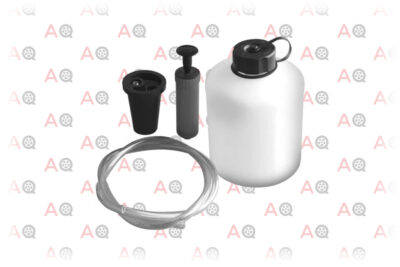
Editor’s Rating:
At a Glance:
- Powered by: Hand pump
- Capacity: 1.7qts
- Speed: 5 minutes for a lawnmower engine
What Makes It Good?
Take the Mityvac and shrink it down to a quarter of the size, and you have the Briggs & Stratton Oil Extraction Pump. It’s a really solid unit with a good pump and easy to use design, but only if you don’t need to extract more than one and a half quarts.
The nice thing about a small extractor like the B & S is that it works like bigger vacuum extractors. You insert the hose into the oil, draw a vacuum and let it work. Many small volume extractors, like the syringe style Mityvac, require you to constantly pull on a plunger to draw out the oil. With the B & S, though, you can eat a cheeseburger while it sucks the oil out of your quad.
What Could Be Better?
It could be bigger, since it can’t hold much. We know that’s not the point, it’s meant for small engines, and it works okay for that, but still, it could be just a little bit bigger. There are a lot of motors that use two quarts.
You’ll also have to make sure the pump creates an excellent connection to the container. It has a habit of popping off if it isn’t seated correctly. If it starts to separate as you are extracting, you’ll have to look silly standing on the container with one foot, pumping with one hand and holding the hose with the other.
Pros
- Compact and convenient design
- Fast for a tiny unit
- Inexpensive
Cons
- Not good for larger engines
- Pump can be temperamental
9. Best Inexpensive Electric Pump: Mannew 12v 60w

Editor’s Rating:
At a Glance:
- Powered by: 12v electricity
- Capacity: Doesn’t come with its own reservoir
- Speed: A few minutes for an average motor
What Makes It Good?
This is a generic extractor pump. The kind that has a different label depending on where you buy it, but they are all actually the same. That’s great if you just want a simple electric pump for cheap. It’s got all the stuff you want: a pump, some hoses, battery clamps, an on-off switch. It doesn’t have a reservoir, but that’s just an opportunity for you to get creative and make it as big as you want.
It’s also easy to reverse the flow, just switch the in and out. That way, you can pump the old oil out, then pump new oil in. At less than ¼ the price of the Jabsco. Honestly, what more could you want?
What Could Be Better?
The leads are a little short, and the included hoses are only “good enough.” You’ll have to source your own bucket, and when you do, grab a new set of hoses too. Other than that, there’s really nothing to complain about.
The pump is fast, can transfer oil, and does exactly what it says it does. Most complaints will come from people who expect too much of a cheap little pump. For instance, it won’t run for hours on end, it will overheat and break. So don’t expect it to do that; just use it for 20 minutes at a time max.
Pros
- Fast
- Inexpensive
- Reversible
Cons
- Doesn't come with its own reservoir
- Included hoses and wires are short
10. Best Syringe-Style: Mityvac 7-½" Extractor

Editor’s Rating:
At a Glance:
- Powered by: Hand plunger
- Capacity: .35qts
- Speed: Pretty fast for ¼ quart, but it would take you all day to drain the average engine
What Makes It Good?
Syringe style extractors are probably the most intuitive tools on this list. They have a plunger on one end and a tube on the other. You pull on the plunger and suck up whatever is on the other end of the tube. If you look at a unit like the Mityvac Fluid Evacuator and gawk at the complexity, let the simplicity of this tool calm your mind.
The syringe style design makes it perfect for a few highly specific applications. It’s really, really good for very viscous fluids, like gear oil. You can fish the line into your differential and pull on the plunger to extract a sample very easily. It’s also perfect for places where you only need to suck out a small amount of liquid, like a clutch fluid reservoir or power steering pump.
The small size and fully contained design of the syringe make it the cleanest, most straightforward way to draw fluid out of tight spaces.
What Could Be Better?
It’s really only suitable for extracting small amounts of fluid. Even if you have a lawnmower, you’ll still have to do multiple draws with this extractor. It’s for that reason that it can feel a little expensive. You can get the Briggs & Stratton for the same price. It actually pulls a vacuum and can hold five times as much.
The thing is that the Mityvac syringe is of excellent quality. We rated it low on this list because if you are extracting oil, chances are you are changing the oil on your vehicle. Even smaller engines like on a dirtbike hold more oil than you would want to ever draw out with a small unit like this. On a list of small fluid extractors, though, this would be near the top. Just use it for what it’s for, and you’ll be happy.
Pros
- Super simple
- Easy to clean
- Good for high viscosity oils
Cons
- Holds very little
- A bit expensive for what it is
All About Auto Oil Extraction
Once you’ve chosen the oil extractor of your dreams, you are ready to use it. We’ve compiled some tips, tricks, and knowledge to help you along.
The Advantages of Using an Extractor
Draining oil from a car isn’t hard. The oil pan has a plug on the bottom, and gravity tends to work great for spilling out fluids; it might seem unnecessary to introduce a new machine into the equation. Extractors offer some really nice advantages that make them worth paying for, though.
Reduced Mess During Oil Changes
For people working in their driveway or on the street, this is probably the biggest advantage. When you use an oil extractor, which we teach you how to do down here, you suck all the oil straight into an easy to move container. No sloshing drain pans, no dripping after you put the plug back, and no more oil spraying everywhere because some designer decided that right underneath the drain plug is the perfect place for a torsion bar. Just slurp, and you are done.
You Don’t Need a Jack
As much fun as crawling underneath a car is, we are going to bet that it’s not your favorite part of car maintenance. Good news, with an oil extractor, you pull all the oil out of the top of the motor. You don’t need to lift the car. You won’t have to crawl across hot concrete just to find out you grabbed a 13mm instead of a 14mm and have to crawl back out.
Extractors Are Efficient
People will debate this until the last internal combustion engine burns its last ounce of fuel. Still, most people will be able to extract more oil using an extractor than just pulling the drain plug. For a pan drain to work correctly, you must make sure your car is sitting level. You also have to have a drain hole that is actually on the bottom of the pan. If you want another opinion, Drivetribe did an excellent breakdown here.
Top Tips for Using an Extractor
Some extractors, like the Mityvac syringe style, don’t need any explanation. Others, like the Topsider and all of its competition, can be a bit complicated. These tips can save you a lot of time and get your car back to doing burnouts as fast as possible.
If you want to see a full tutorial on how to use an extractor, this guy on youtube does a good job. We feel comfortable linking his video since he likes the same extractor we recommend as our top pick, the Topsider. If you were persuaded, the video is a bonus validation.
Make Sure You Have the Correct Hoses
Check that you have the right hoses before you do anything. Most of the time, you are going to be drawing out the oil through the dipstick tube. Your whole operation will come to a screeching halt if you set everything up and then learn that the included hose won’t actually fit your car’s access.
Worse still, and you may want to check this before you even buy an extractor, some modern cars don’t have a dipstick. You’ll have to look online for where the top access is if it exists.
Know About How Much Oil You’ll Be Extracting
If you have a car that uses x-qts of oil typically, you should plan to draw out no more than x-qts. It’s good to know that for two reasons. The first is so that you make sure you have the right size extractor. If you have a big truck that needs 7 liters and bought a standard 6qts extractor like the Hydro-Turf, you have a recipe for a mess.
The second reason isn’t extractor specific, but you can identify a problem if there’s too much or too little fluid that drains out. If you think your car needs 4qts of oil and you only pull out 2qts, they had to go somewhere. Either your car leaked them out, or it burned them off. Both are problems that you should keep an eye on.
If you think the car has 4qts of oil and you pull out 6qts, you should probably take it to a mechanic immediately. The most common reason to have extra fluid in the oil pan is that the excess fluid is coolant, and there’s no good reason for coolant not to remain trapped in coolant channels. Or you have a buddy playing a prank on you by overfilling your oil to make the car smoke and stink. You’ll have to make that call
Warm Up the Engine
Oil flows best when it’s warm. In fact, unless you have a stronger model like the Hydro-Turf we mentioned, your extractor might not work at all if the oil is too thick and cold. The easiest thing to do is just go on a quick drive. That’s good advice for any oil change, it gets the oil around and flowing so you can make sure you drain it completely.
Stop When You Hear It Suck Air
Like the Mityvac Plus, some extractors have easy to read marks on the side and automatic shutoff valves. However, most don’t, so you’ll have to know when the oil pan is empty by comparing how much oil you think needed to be drained with the sound the extractor is making. The telltale empty noise sounds like blowing bubbles through a straw.
Before you completely remove the hose, poke around with it to make sure there aren’t any pockets of oil left in the pan. You can’t hurt anything on the bottom end of the engine. Plastic tubing is a poor tool for scratching cast metals, so don’t worry about damaging anything by poking around.
Inspect the Oil
Extracting the oil into an extractor, especially one that’s easy to see into like the OEM above, makes it easy to quickly inspect the oil for a good indicator of engine health. It’s like doing a blood test, just a bit messier. Car Labs has a handy visual breakdown here.
Have a Plan for Disposing of the Oil
Oil is bad for the environment, make sure you have a plan for disposing of the oil after you drain it. Most of the extractors, especially very transportable ones like the Hydro-Turf and the LiquiVac, you can just take it straight to a place that recycles oil and dump it out
Oil Change Frequently Asked Questions

Everyone knows that cars should have their oil changed from time to time, but there are some considerations surrounding oil changes. If you need some help, make sure to read our guide on changing the oil in your own car.
Why Should You Change the Oil?
As oil runs through your engine, it heats up. When it heats up, it begins to break down and become less affected. Over a long enough time, the oil will have broken down so much that it is not doing its job anymore. That leads to extra heat, which leads to parts wearing down faster. Your engine suffers if those things happen.
How Often Should You Change the Oil?
People like to argue about how often you should change your oil, but we like Car and Driver’s breakdown here. Basically, change your oil when your manual says to do it, and do it more often if you regularly drive in a dirty area.
Is Synthetic Better Than Conventional?
It depends, but for the most part, yes. It takes longer to break down and has detergents that help keep your engine cleaner. Is it worth the extra price? If you are doing regular oil changes and don’t drive your car like a maniac, then probably not. The advantages of synthetic oil are mostly seen when you drive a car hard, and you drive it for a long time between oil changes.
Enjoy Easier, Cleaner Maintenance
The biggest advantage of using an oil extractor compared to conventional methods is how clean everything stays. That makes changing the oil a much more pleasant experience. Gone will be the days of smelling like burnt oil for the entire week. Gone will be the days of clothes and hands covered in stains. You won’t be banished outside after doing car maintenance, and your neighbors will thank you for not leaving huge oil stains on the driveway.
The only downside is that you won’t have an excuse not to change your oil anymore. At least with a good extractor, you can have a drink while it drains.


